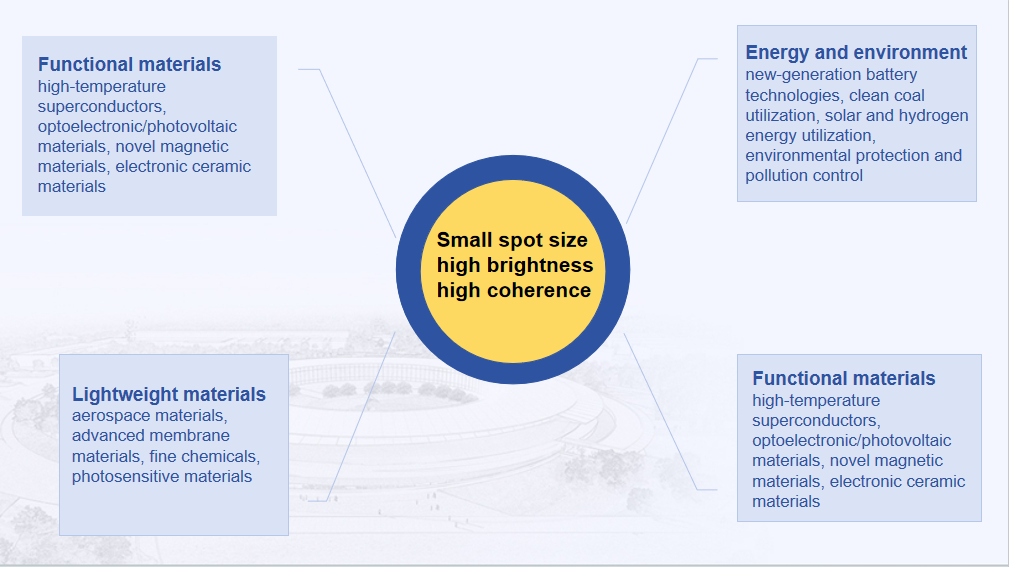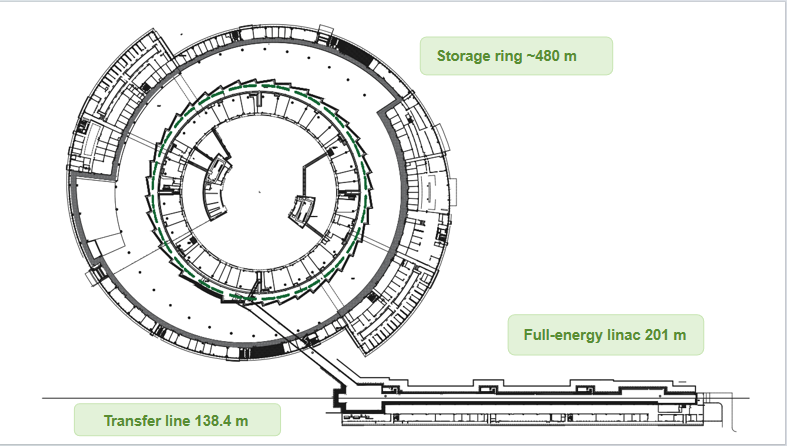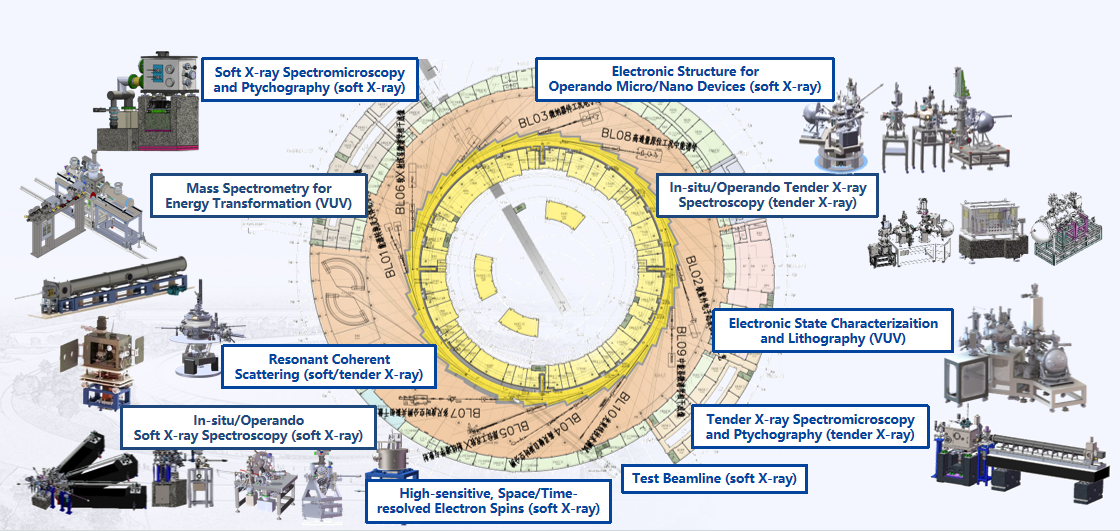Mission & Goals
The Hefei Advanced Light Facility (HALF),a major national science and technology infrastructure, is a fourth-generation low-energy synchrotron radiation machine based on the technology of the diffraction-limited storage ring. The brightness and coherence of the generated soft X-rays are more than a hundred times higher than those of third-generation light sources. It will develop new experimental methodologies with higher precision and sensitivity in the dimensions of space, time, and energy, making it an important research platform for the study of the microscopic behavior of particles, the structure of lightweight elements, and the changes in the electronic, chemical, and spin states of materials.
Key Technical Specifications of the Hefei Advanced Light Source:
>The storage ring has a beam energy of 2.2 GeV with capability for future energy increase to 2.4~2.5 GeV. The natural beam emittance at 2.2 GeV is 86 pm•rad.
> In the photon optimization energy range, the peak brightness is higher than 10²1 ph•s-1• mm-2•mrad-2•(0.1%BW)-1, and the proportion of coherent photons under the natural emittance reaches 30% at a photon energy of 1 keV.
>The capacity of high-performance beamlines is not less than 35, with the first batch consisting of 10 beamlines.
Upon completion, the Hefei Advanced Light Source will emerge as the world's most sophisticated low-energy synchrotron radiation facility. It will propel Hefei to become a world-class hub for photon science and applied research, establish China's full-spectrum advanced light source system, and drive progress across multiple frontiers: advancing cutting-edge technologies, enhancing innovation capabilities, transforming strategic industries, and elevating comprehensive national strength.
Science & Applications
Leverage the advantages of low-energy diffraction-limited storage light source in terms of brightness, coherence, energy and spatiotemporal resolution to develop new experimental methods with higher precision and sensitivity across spatial, temporal and energy dimensions. This will enable precise measurements of the electronic, chemical and spin states of non-uniform complex systems, achieving significant breakthroughs in the national strategic fields such as functional materials, lightweight materials, energy and environment, life and health. By acting as an innovative engine, HALF will promote industrial technological innovation and applications, and support the construction of innovative country of China.

Scheme & Plan
Construction period: 64 months (June 2023 to Sep. 2028)
Accelerator complex:
1) full-energy linac and linac-to-ring transfer line
2) diffraction-limited storage ring: 20 identical cells with 40 long and short straight sections
Beamlines: total of 35 beamlines planed, 10 of them to be constructed in phase I.


Construction Location
HALF is located in the future big science city of Hefei (Gangji Town, Changfeng County), about 17 kilometers away from Xinqiao Airport and 24 kilometers away from the National Synchrotron Radiation Laboratory (NSRL) of University of Science and Technology of China (USTC).
Organization & Committee
HALF Engineering Management Center | ||
FENG Donglai | Director-Genera | dlfeng@ustc.edu.cn |
LIU Xiaosong | Executive Deputy Director-General & Deputy Chief Engineer | xsliu19@ustc.edu.cn |
FENG Guangyao | Chief Engineer & Deputy Director-General | fenggy@ustc.edu.cn |
LI Liangbin | Deputy Director-General | lbli@ustc.edu.cn |
LENG Yongbin | Deputy Director-General & Deputy Chief Engineer | lengyb@ustc.edu.cn |
PAN Yang | Chief Building Services Engineer | panyang@ustc.edu.cn |
YU Qin | Chief Economist | yuqin@ustc.edu.cn |
LI Qi | Deputy Chief Economist | qili@nao.cas.cn |
ZHANG Chen | Deputy Chief Economist | zhcheng1@ustc.edu.cn |
ZHANG Shancai | Deputy Chief Engineer | shancai@ustc.edu.cn |
BAI Zhenghe | Deputy Chief Engineer | baizhe@ustc.edu.cn |
DU xuewei | Deputy Chief Engineer | xwdu@ustc.edu.cn |
JIANG Zheng | Assistant Chief Engineer | jiangz@ustc.edu.cn |
QI Zemin | Deputy Chief Building Services Engineer | zmqi@ustc.edu.cn |
LIU Gongfa | Deputy Chief Building Services Engineer | gfliu@ustc.edu.cn |
ZHU Zian | Deputy Chief Building Services Engineer | zianzhu@ustc.edu.cn |
Committee on Engineering Science and Technology | ||
Director | ZHAN Wenlong | Academician, Chinese Academy of Sciences |
Deputy Director | SUN Shigang | Academician, Xiamen University |
Members(alphabetical) | ||
CHEN Hesheng | Academician, Institute of High Energy Physics, Chinese Academy of Sciences | |
CHEN Senyu | Academician, Institute of High Energy Physics, Chinese Academy of Sciences | |
HE Duohui | Academician, University of Science and Technology of China | |
LI Yongfang | Academician, Institute of Chemistry, Chinese Academy of Sciences | |
XIA Jiawen | Academician, Institute of Modern Physics, Chinese Academy of Sciences | |
XIE Yi | Academician, University of Science and Technology of China | |
XU Jian | Academician, China National Machinery Industry Corporation | |
ZHAO Hongwei | Academician, Institute of Modern Physics, Chinese Academy of Sciences | |
ZHAO Yuliang | Academician, National Center for Nanoscience and Technology | |
ZHAO Zhentang | Academician, Shanghai Advanced Research Institute, Chinese Academy of Sciences | |
ZHAO Zhengguo | Academician, University of Science and Technology of China | |
DING Hong | Academician, Shanghai Jiaotong University | |
DONG Yuhui | Research Fellow, Institute of High Energy Physics, Chinese Academy of Sciences | |
LI Hong | Research Fellow, Institute of Physics, Chinese Academy of Sciences | |
LIU Kexin | Professor, Peking University | |
PAN Weimin | Research Fellow, Institute of High Energy Physics, Chinese Academy of Sciences | |
QI Fei | Professor, Shanghai Jiaotong University | |
TANG Chuanxiang | Professor, Tsinghua University | |
WANG Sheng | Research Fellow, Institute of High Energy Physics, Chinese Academy of Sciences | |
WANG Zhanshan | Professor, Tongji University | |
WU Yizheng | Professor, Fudan University | |
XU Ruiming | Professor, Institute of Biophysics, Chinese Academy of Sciences | |
YANG Guoqiang | Research Fellow, University of Chinese Academy of Sciences | |
YIN Lixin | Research Fellow, Shanghai Advanced Research Institute, Chinese Academy of Sciences | |
SAC-Scientific Advisory Committee(alphabetical) | |
Prof. Dr. Gabriel Aeppli | Paul Scherrer Institute, Switzerland |
Dr. Jean Daillant | European Synchrotron Radiation Facility, France |
Dr. Christian David | Paul Scherrer Institute, Switzerland |
Dr. Yuhui Dong | Institute of High Energy Physics, CAS, China |
Dr. Mark Heron | Diamond Light Source, United Kingdom |
Prof. Dr. Zahid Hussain | Lawrence Berkeley National Laboratory, United States |
Dr. Tetsuya Ishikawa | RIKEN SPring-8 Center, Japan |
Prof. Dr. George Sawatzky | The University of British Columbia, Canada |
Dr. Kawal Sawhney | Diamond Light Source, United Kingdom |
Prof. Dr. Kenya Shimada | Hiroshima University, Japan |
Dr. Jean Susini | Synchrotron SOLEIL, France |
Dr. Harry Westfahl Junior | Brazilian Synchrotron Light Laboratory, Brazil |
MAC-Machine Advisory Committee(alphabetical) | |
Prof. Alexander Wu Chao | Stanford University / Tsinghua University, United States |
Dr. Zheqiao Geng | Paul Scherrer Institute, Switzerland |
Prof. Ping He | Institute of High Energy Physics, CAS, China |
Dr. Gwo-Huei Luo | National Synchrotron Radiation Research Center, Taiwan, China |
Dr. Oleg B. Malyshev | STFC Daresbury Laboratory, United Kingdom |
Dr. Amor Nadji | Synchrotron SOLEIL, France |
Prof. Takashi Obina | High Energy Accelerator Research Organization, Japan |
Prof. Qing Qin | European Synchrotron Radiation Facility, France |
Prof. Shigemi Sasaki | Hiroshima University, Japan |
Dr. Hitoshi Tanaka | RIKEN SPring-8 Center, Japan |
Prof. Zhentang Zhao | Shanghai Advanced Research Institute, CAS, China |

